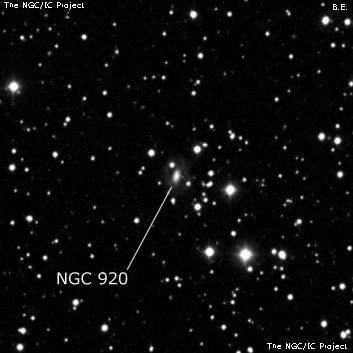
Guillaume Bigourdan discovered IC 1799 = Big. 251 on 28 Jan 1891. Lewis Swift is likely the original discoverer on 11 Sep 1885, but his position was 1.0 minute of time too small and Bigourdan assumed his discovery was new. I suggested the equivalence of NGC 920 = IC 1799 = UGC 1943 to Corwin and Steinicke, instead of the standard identification NGC 920 = UGC 1920. They both concur with this identity. See NGC 920, as well as Corwin's identification notes.
400/500mm - 17.5" (8/5/97): fairly faint, fairly small, elongated 5:2 SW-NE, broad concentration to a brighter core. A mag 14 star is at the west edge . Viewed after glimpsing UGC 1920 (the galaxy taken to be NGC 920), which is 9.5' W. UGC 1920 (listed as NGC 920 in all modern sources) appeared extremely faint, moderately large, ~1.5' diameter, very low surface brightness, required averted vision to glimpse. This roundish unconcentrated glow is situated within a group of stars including a mag 11 star 1.6' WSW and mag 13 stars 1' NW and 1' SE. I would not have noticed this object without averted vision and knowing the exact location using a printed finder chart. Located 9.5' W of much brighter NGC 920 = IC 1799 and 15' WNW of NGC 933.
17.5" (11/26/94): fairly faint, fairly small, elongated 5:2 SSW-NNE, 1.0'x0.4', broad concentration to a fairly bright core and occasional stellar nucleus. A mag 14 star is very close west and a mag 12 star (unequal double) is 1.4' NNW. Located in a rich star field 11' WSW of a mag 7 SAO 38067. Brighter of a pair with NGC 933 6.6' ESE.
Notes by Steve Gottlieb